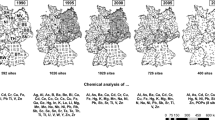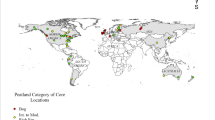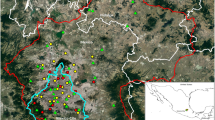Abstract
National networks detect multi-state trends in element deposition using direct measurement methods. Biomonitoring techniques have been used to examine deposition in local areas and around point sources. We sought to determine the efficacy of a moss bag technique to detect element deposition trends on a mid-range (state) scale, and to compare these results with those of the National Acid Deposition Program/National Trends Network (NADP/NTN, 1999). We sampled heavy metals, sulfur, and nitrogen deposition (21 elements) using mesh bags containing Sphagnum russowii at nine sites, over a 375 km transect crossing southern Wisconsin (upper Midwest, USA). We found statistically significant trends of decreasing deposition in a northwesterly direction for 13 elements: Al, B, Ca, Cd, Co, Cu, Cr, Fe, Mg, Mn, Ni, S, and Zn. Six of these have moderate to large changes in concentration (14–37%). The trends for Ca, Mg, and S are consistent with regional deposition patterns in 1998 isopleth maps from the NADP/NTN (1999) which are derived from a sampling array far less dense than the transect sites. This national network indicates that Ca and Mg increase to the southeast, beyond Wisconsin borders. The fact that the present study demonstrates strong correlations between both of these elements (Ca and Mg) and Al, B, Cr, Cu, Fe, Mn, Ni, and Zn (mean r for all correlations = 0.75, p < 0.02) implies that these correlated elements also increase to the southeast in neighboring states.
Similar content being viewed by others
References
Adamo, P., Giordano, S., Vingiani, S., Castaldo Cobianchi, R. and Violante, P.: 2003, ‘Trace element accumulation by moss and lichen exposed in bags in the city of Naples (Italy),’, Env. Pollut. 122 (1), 91–103.
Al-Radady, A.S., Davies, B.E. and French, M.J.: 1993, ‘A new design of moss bag to monitor metal deposition both indoors and outdoors,’, Sci. Total Environ. 133(3), 275–283.
Brown, D.H.: 1984, ‘Uptake of Mineral Elements and Their Use in Pollution Monitoring,’, in A.F. Dyer, J.G. Duckett (eds), The Experimental Biology of Bryophytes, Academic Press, Orlando, FL, pp. 229–255.
Buonicore, A.J. and Davis, W.T. (eds): 1992, Air Pollution Engineering Manual, Air and Waste Management Association, Van Nostrand Reinhold, New York, 918 pp.
Čeburnis, D. and Valiulis, D.: 1999, ‘Investigation of absolute metal uptake efficiency from precipitation in moss,’, Sci. Total Environ. 226(2/3), 247–253.
Clough, W.S.: 1975, ‘The deposition of particles on moss and grass surfaces,’, Atmos. Environ. 9, 1113–1119.
Clymo, R.S.: 1963, ‘Ion exchange in Sphagnum and its relation to bog ecology,’, Ann. Bot. 27, 309–324.
Curtis, John T.: 1959, The Vegetation of Wisconsin, University of Wisconsin Press, pp. 657.
Draper, N.R. and Smith, H.: 1981, Applied Regression Analysis, 2nd ed., Wiley, New York, pp. 709.
EPA: 1995, AP-42, 5th ed., US EPA Office of Air Quality, Planning and Standards, pp. 1.1–1.33.
Fernández, J.A., Aboal, J.R. and Carballeira, A.: 2000a, ‘Use of native and transplanted mosses as complementary techniques for biomonitoring mercury around an industrial facility,’, Sci. Total Environ. 256(2/3), 151–161.
Fernández, J.A., Rey, A. and Carballeira, A.: 2000b, ‘An extended study of heavy metal deposition in Galicia (NW Spain) based on moss analysis,’, Sci. Total Environ. 254, 31–44.
Gailey, F.A.Y. and Lloyd, O.LI.: 1986, ‘Methodological investigations into low technology monitoring of atmospheric metal pollution: Part 3. The degree of replicability of the metal concentrations,’, Environ. Pollut. (Ser. B) 12, 85–109.
Goodarzi, F., Sanei, H., Garrett, R.G. and Duncan, W.F.: 2002, ‘Accumulation of trace elements on the surface soil around the Trail smelter, British Columbia,’, Can. Environ. Geol. 43(1/2), 29–38.
Hynninen, V.: 1986, ‘Monitoring of airborne metal pollution with moss bags near an industrial source at Harjavalta, southwest Finland,’, Ann. Bot. Fennici 23, 83–90.
Knight, A.H., Crooke, W.M. and Inkson, R.H.E.: 1961, ‘Cation-exchange capacities of tissues of higher and lower plants and their related uronic acid contents,’, Nature 192, 142–143.
Lodenius, M.: 1998, ‘Dry and wet deposition of mercury near a chlor-alkali plant,’, Sci. Total Environ. 213(1–3), 53–56.
LeBlanc, F. and De Sloover, J.: 1970, ‘Relation between industrialization and the distribution and growth of epiphytic lichens and mosses in Montreal,’, Can. J. Bot. 48, 1485–1496.
Makholm, M.: 2003, ‘Assessing Air Pollution Impacts: Biomonitoring with Lichens and Mosses’. Ph.D. Thesis, University of Wisconsin-Madison.
Midwest Regional Climatic Center (MRCC): 2001, http://mcc.sws.uiuc.edu/Introduction/data.html.
NADP/NTN: 1999, http://nadp.sws.uiuc.edu/.
Ott, W.R.: 1990, ‘A physical explanation of the lognormality of pollutant concentrations,’, J. Waste Manag. Assoc., 40(10) 1378–1383.
Percy, K.E. and Borland, S.A.:1985, ‘A Multivariate analysis of element concentrations in Sphagnum magellanicum Brid. in the maritime provinces, Canada,’, Water Air Soil Pollut. 25, 331–338.
Ruhling, A. and Tyler, G.:1970, ‘Sorption and retention of heavy metals in the woodland moss Hylocomium splendens (Hedw.),’, Br. et Sch. Oikos 21, 92–97.
Snedecor, G.W. and Cochran, W.G.: 1980, Statistical Methods, 7th ed., Iowa State University Press, pp. 37, 280.
Steinnes, E., Rambæk, J.P. and Hanssen, J.E.: 1992, ‘Large scale multi-element survey of atmospheric deposition using naturally growing moss as biomonitor,’, Chemosphere 25(5), 735–752.
Temple, P.J., McLaughlin, D.L., Linzon, S.N. and Wills, R.: 1981, ‘Moss bags as monitors of atmospheric deposition,’, J. Air Pollut. Control Assoc. 31, 668–670.
Thoni, L., Schnyder, N. and Krieg, F.: 1996, ‘Comparison of metal concentrations in three species of mosses and metal freights in bulk precipitations,’, Fresenius J. Anal. Chem. 354, 703–708.
Tyler, G.: 1990, ‘Bryophytes and heavy metals: A literature review,’, Bot. J. Linnean Soc. 104, 231–253.
UW-Madison, Soil and Plant Analysis Lab.: 2003, http://uwlab.soils.wisc.edu.
Viskari, E.L., Rekila, R., Roy, S., Lehto, O., Ruuskanen, J. and Karenlampi, L.: 1997, ‘Airborne pollutants along a roadside: Assessment using snow analyses and moss bags,’, Environ. Pollut. 97(1/2), 153–160.
Wegener, J.W.M., Van Schaik, M.J.M. and Aiking, H.: 1992, ‘Active biomonitoring of polycyclic aromatic hydrocarbons by means of mosses,’, Environ. Pollut. 76(1), 15–18.
Winner, W.E., Atkinson, C.J. and Nash, T.H. III: 1988, ‘Comparisons of SO2 absorption capacities of mosses, lichens and vascular plants in diverse habitats,’, Bibl. Lichenol. 30, 217–230.
Wisconsin Department of Natural Resources (WDNR): 1998, ‘Air Emissions Inventory Database’.
Xiao, Z., Sommar, J., Lindqvist, O., Tan, H. and He, J.: 1998, ‘Atmospheric mercury deposition on Fanjing Mountain Nature Reserve, Guizhou, China,’, Chemosphere 36(10), 2191–2200.
Author information
Authors and Affiliations
Corresponding author
Rights and permissions
About this article
Cite this article
Makholm, M.M., Mladenoff, D.J. Efficacy of a Biomonitoring (Moss Bag) Technique for Determining Element Deposition Trends on a Mid-Range (375 Km) Scale. Environ Monit Assess 104, 1–18 (2005). https://doi.org/10.1007/s10661-005-6398-3
Received:
Accepted:
Issue Date:
DOI: https://doi.org/10.1007/s10661-005-6398-3




